Configure SP-Initiated SSO for Procore in Okta
Note
If your organization is using the Portfolio Financials and Capital Planning products in Procore, you will need to reach out to your Procore point of contact or the Support team to set up your Okta SSO.
Objective
To configure Procore-initiated SSO for Okta. (SP-initiated SSO)
Background
If your company wants to configure Single Sign-On with Okta, you can leverage one of Procore's supported SSO solutions:
- Identity Provider Initiated (IdP-initiated) SSO. With this option, your end users must log into your Identity Provider's SSO page (for example, Azure AD or Okta) and then click an icon to log into and open the Procore web application. To configure this solution, see Configure Procore for IdP-Initiated Azure Active Directory SSO or Configure Procore for IdP-Initiated Okta SSO.
OR - Service Provider Initiated (SP-initiated) SSO. Referred to as Procore-initiated SSO, this option gives your end users the ability to sign into the Procore Login page and then sends an authorization request to the IdP. Once the IdP authenticates the user's identify, the user is logged into Procore. To configure this solution with Okta, see the Steps below.
Things to Consider
- Required Permissions:
- Administrator permissions to Okta
AND - 'Admin' level permissions to Procore's Company level Admin tool.
- Administrator permissions to Okta
- Prerequisites:
- Complete all the Preparation Phase steps outlined in Setup Guide: Okta.
- Supported Authentication Protocol:
- Security Assertion Markup Language (SAML 2.0)
- Security Assertion Markup Language (SAML 2.0)
- Additional Information:
- Limitations:
- Just In Time (JIT) provisioning is NOT supported.
Steps
Step 1: Add the Procore App to Okta
- Log in to Okta as an Administrator.
- Click Admin.

- Choose Applications > Applications.

- Click Add Application.
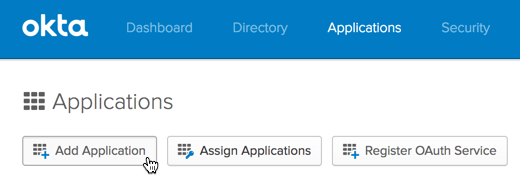
- In the Search for an Application box, search for Procore. When Procore's Okta-Verified SAML app appears, click Add.

- Under General Settings, do the following:
- Application Label. Type a name for the new application. For example, type: Procore
- Application Visibility. Leave both of these checkboxes blank. This will allow the Procore icon to appear in Okta and on the Okta login page. If you place a checkmark in this box, the logo with NOT appear.
- Browser Plugin Auto-Submit. Ensure a checkmark appears in this box.
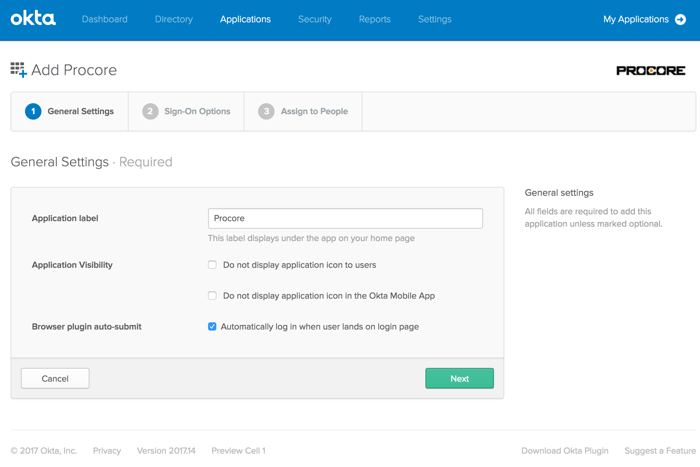
- Click Next.
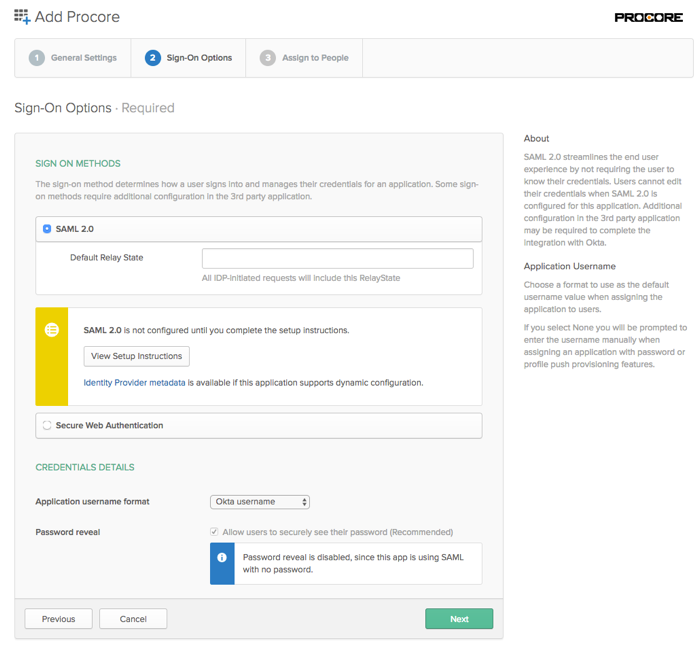
- Click View Setup Instructions.
This opens the Setup SSO page in a new web browser tab. Leave this page open in your browser. Later, you will need to copy information in this page when you configure the Okta SSO settings in the Procore web application.
Important! When copying the X.509 Certificate string, do NOT copy the "------------BEGIN CERTIFICATE------------" and "------------END CERTIFICATE------------" markers. Only copy the text that resides between these markers.
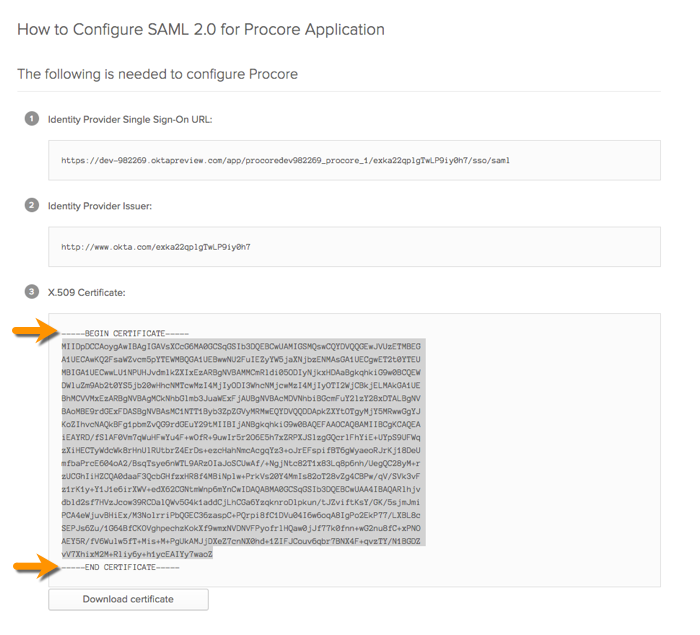
- Return to your open browser tab with Okta's Sign On page, as shown below. Then ensure that Okta Username is selected in the Application Username Format list.

- Click Next.
- Place a checkmark next to the name of your organization's Procore users in the People list.
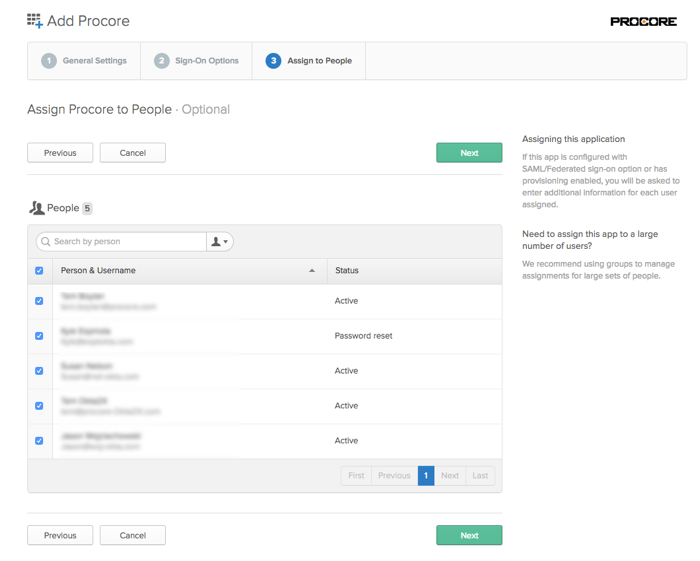
- Click Next.
- Verify that the attribute settings are correct for all of your Procore users. This Otka username is an email address. This is the address that you Procore users will use to log in to your Procore + Okta SSO Integration.
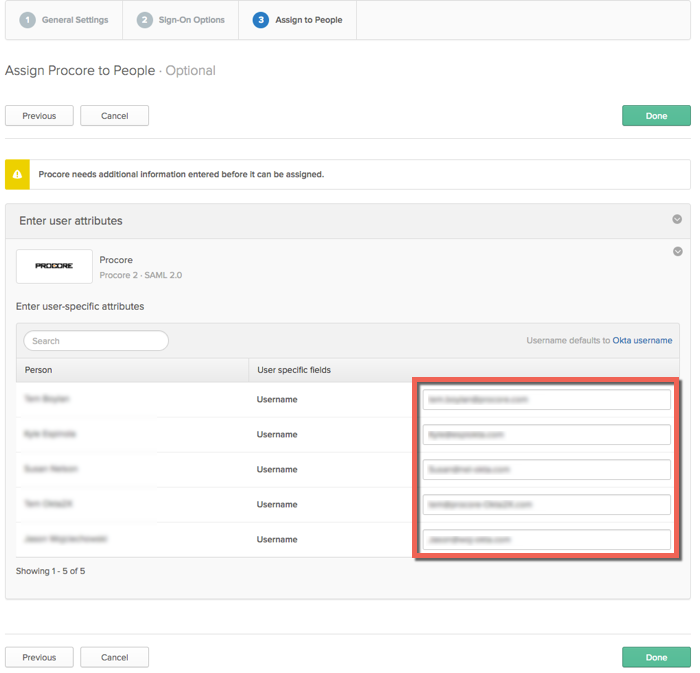
- Click Done.
- Continue with the next procedure.
Step 2: Configure the Okta SSO Settings In Procore
-
Login into the Procore web application.
Note: You must log in using an account that has 'Admin' permission to the company's Admin tool. - Navigate to the company's Admin tool.
- Under Administrative Settings, click Single Sign On Configuration.
- Enter the following information:
- Single Sign On Issuer URL
Paste the 'Identity Provider Single Sign-On URL' that you from Okta into this field. - Single Sign On Target URL.
Paste the Single Sign On Target URL from Okta in this field. - Single Sign On x509
Paste the 'X509 Certificate' that you copied from Okta into this field.
Important: When copying the certificate information from Okta, do NOT copy the "------------BEGIN CERTIFICATE------------" and "------------END CERTIFICATE------------" markers. You only want to copy the text that resides between these markers.
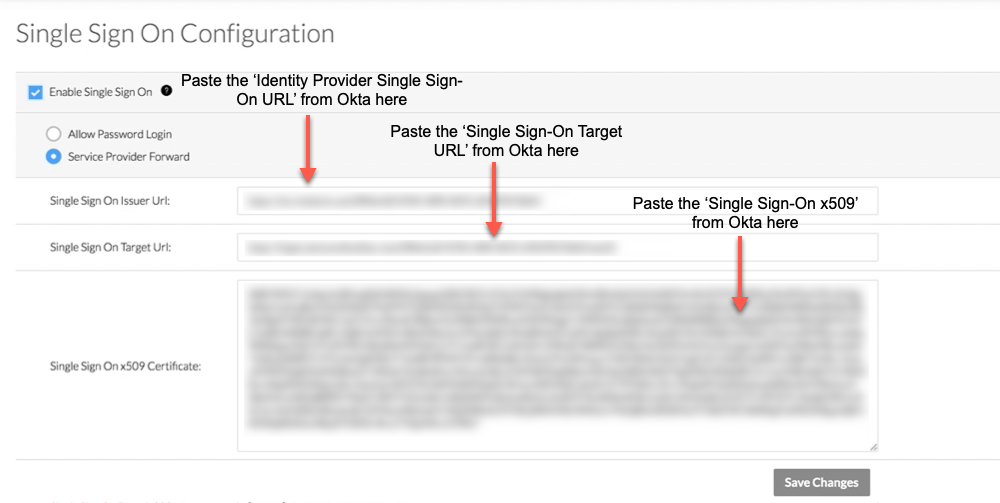
- Single Sign On Issuer URL
- Click Save Changes.
- Next, reach out to your company's Procore point of contact or contact Procore Support to request that they enter the domains you want to target for authentication via SSO. Procore must enter these domains on your behalf.
- Once the domain(s) have been entered by Procore, take the final steps to enable SSO for your company:
- Mark the Enable Single Sign On box in Procore's SSO configuration settings.
- Select Service Provider Forward to enable an SP-initiated flow.
- Click Save.
Authentication via the configured SSO method will become active immediately after saving the final completed configuration.


